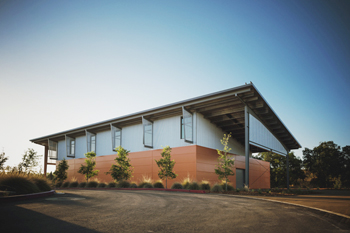Spotlight: UC Davis Opens Sustainable Winery Building
 DAVIS, Calif. — The University of California, Davis will soon be home to the first self-sustainable winery after celebrating the opening of the Jess S. Jackson Sustainable Winery Building on May 29. When the $4 million structure is fully equipped, it will allow the adjacent teaching and research winery, brewery and food-processing facility for the school’s Department of Viticulture and Enology to be completely self-sustainable, using energy and water captured on site.
DAVIS, Calif. — The University of California, Davis will soon be home to the first self-sustainable winery after celebrating the opening of the Jess S. Jackson Sustainable Winery Building on May 29. When the $4 million structure is fully equipped, it will allow the adjacent teaching and research winery, brewery and food-processing facility for the school’s Department of Viticulture and Enology to be completely self-sustainable, using energy and water captured on site.
“This is basically the systems building that makes the winery operate self-sustainably,” said Professor Roger Boulton, a winery-engineering expert and Stephen Sinclair Scott, endowed chair in Enology at the university.
The building is anticipated to be the first Net Zero Energy building under the Living Building Challenge at any university and the second building to meet the challenge in California. The design-build team consists of Oakland, Calif.-based Pankow Builders; Emeryville, Calif.-based Siegel & Strain Architects; and Sacramento, Calif.-based Guttman & Blaevoet Engineering.
About 10 years in the making, the new building is what Boulton called “the most complicated LEED Platinum building ever built” and the “most valuable square footage built in California in the last 10 years.”
While the structure appears as a basic orange building from the exterior, the behind-the-scenes workings of the 8,000-square-foot facility are much more complex. It is built to feature 10 modular spaces that will house equipment for a variety of self-sustaining technologies.
For instance, there will be a high-purity filtration system so rainwater can be used to clean fermentors and barrels in the winery. Plus, 90 percent of the water from each cleaning cycle will be captured and filtered through a semi-permeable membrane, eventually allowing for the water to be used up to 10 times. The water filtration and recirculation system is scheduled for installation next year.
After that, a system for sequestering carbon dioxide captured from wine fermentation will be installed, making the building “the first place in the world to sequester CO2,” according to Boulton. The carbon dioxide collected from the fermentations will be converted into calcium carbonate, or chalk, upon completion of the sequestration system.
 Other technologies give the building the ability to produce chilled water via a solar-powered icemaker and generate hydrogen gas by electrolysis, fueling a hydrogen fuel cell for nighttime energy use.
Other technologies give the building the ability to produce chilled water via a solar-powered icemaker and generate hydrogen gas by electrolysis, fueling a hydrogen fuel cell for nighttime energy use.
The building is also designed to maintain cool temperatures, even during the extremely hot (some days it’s 100 degrees Fahrenheit) mid-summer days in Davis. The roof overhangs on both the east and west sides of the building to protect it from the sun. Plus, the building is insulated to meet R-59.5 insulation standards in the walls and R-76 standards in the roof, and in the evening, natural ventilation pushes out warm air from the interior.
For additional cooling and heating, the building’s slab contains a tube system, which uses cold water to provide cooling and hot water to provide winter heating. Boulton also said that there are plans to eventually build an underground rock bed that will create thermal mass to offset heat released from the various systems after they are installed.
When everything is installed, the Jess S. Jackson building will be used as part of the Department of Viticulture and Enology’s curriculum. “We don’t have a class that sustainability is in the title of; students are surrounded by it every day,” Boulton said. “The way to teach is not to have to teach. That’s what this is. It’s integrated into the mission of wine making.”
The facility was made possible by a $3 million donation from the late Jess Jackson and his wife, Barbara Banke, who is the proprietor of Jackson Family Wines. It was built after the adjacent teaching and research winery became the first winery in the world to receive LEED Platinum certification in 2010. Located inside the same building, the August A. Busch II Brewing and Food Science Laboratory also became the first such facility to achieve LEED Platinum.
